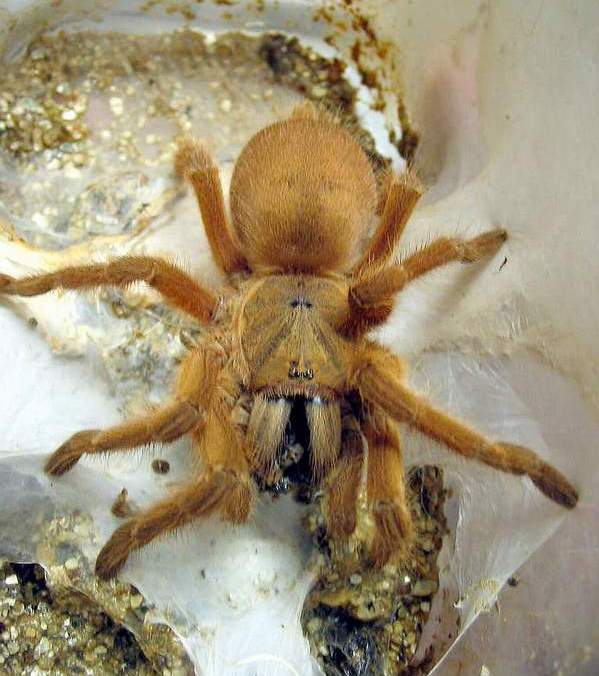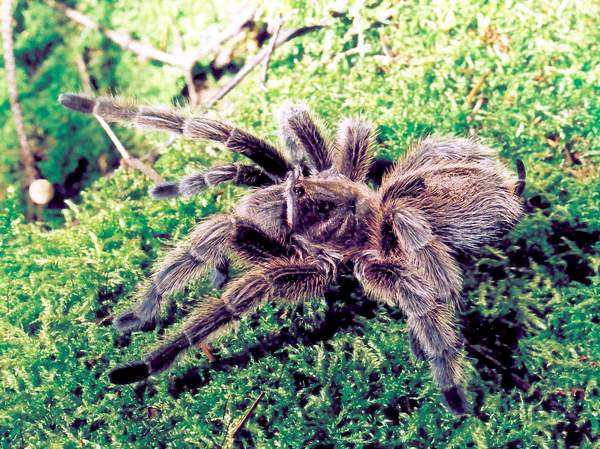Feeding and watering.
As it was already mentionned earlier, all tarantulas are obligate predators and eat solely bestial food.
As it`s well known, in nature tarantulas catch only moving food objects, in captivity is noted to both juvenils and adults on feeding of unmovable objects as well as their parts, pieces of meat and fish (individual).
The most important principle of feeding tarantulas consists of possible more varied diet and food objects must not be dangerous for tarantulas themselves.
The frequency of feeding and size of food objects depends on tarantula age. For intensive growing of youngs is recommended the method of incessant feeding, i.e. after one food object being eaten another is offerred. Under such strategy, which used together with simultaneous keeping under increased temperature young spiders quickly grows noticeably increasing in size with each molting. Within first 2-3 molts the period between moltings counts less month. In any case is recommended to feed young tarantulas not less two times a week. The size of food object for young spiders must not exceed a size of their abdomen.
On the other hand, an intensive feeding of adult spiders accelerates their aging so it is considered the optimal strategy will be to offer the food 2-3 times a month.
 The main diet in captivity are: different species of crickets, roaches, meal worms, zophobus, locusts, frogs, small lizards, «pink» and subadult mouse.
The main diet in captivity are: different species of crickets, roaches, meal worms, zophobus, locusts, frogs, small lizards, «pink» and subadult mouse.
Also is possible to feed a tarantula with other invertebrate and vertebrates from nature, but in this case exists probability of charting in terrarium parasitic organisms and pesticides that can bring a tarantula to die! Use this possibility in the last resort collecting stern objects in places where men economical activity are not conducted.
Remember that spider able without harm for health, at presence of unlimited access to water, dispense with foods by weeks, and adults by months. For example, such giant as Theraphosa blondi, can abandon of food within 2-3 months before and 1-2 month after the molt; for wild caught Grammostola rosea rejection of feeding within half a year and more is physiological particularity.
There was an experiment to find the duration time of tarantula possibility not to eat. Maximum period was stated - two years nine months and nineteen days (Baerg, «A Tarantula»).
As substitute of usual food objects is also possible to feed tarantulas with picies of different meat and fish. Acceptence of such substitutes depends on concrete specimen of tarantula, since some of them never take such food, others willingly eats it.
Do not try to feed a tarantula soon before and after the molt!
In this case active insect (for instance, cricket) will not be eaten and, moreover, can damage with their jaws tarantula cuticle in the rezult of that it is possible to disadvantage consequences for health up to its death.
Try, as less as possible to disturb its at this time and in no event take on hands.
It is reasonable to offer a tarantula food within several days after molt when its exoskeleton hardened. as was it already noted, this period can last a month and more in adult specimens.
 Mentioned earlier known fact of long refusal of food is fixed for chilean tarantula Grammostola rosea, which lives in region with denominated cool period. Obviously, that such behaviour is also possible for some other species of tarantulas, referring to group 2.
Mentioned earlier known fact of long refusal of food is fixed for chilean tarantula Grammostola rosea, which lives in region with denominated cool period. Obviously, that such behaviour is also possible for some other species of tarantulas, referring to group 2.
In any case always take away food object if it is not eaten during the day. The next time You can offer it through day.
It is necessary also to keep a check on hygenic purity in terrarium and remove all organic remainders after meal (pieces of food objects), tarantula droppings.
As it was already mentioned, water is vitally necessary for tarantulas. To keeping tarantulas of average sizes is advisable to install in terrarium water bowl. This is without fall ensuring the access to water for adult specimens of tarantulas. Herewith at the average once in a week change of water is required since many terrestrial species throw chewed remains of food objects and droppings right in water bowl.
Newborn spiderlings and juvenil spiders can be kept without water bowls if a thick layer of moisten substratum is given.
Some amateurs practise to keep tarantulas on measure of increases the age on dry soil under constantly pervaded water bowl, hereunder, avoiding possibility the appearances in terrarium parasit organisms and funguses. Such keeping is possible for tarantulas of group 2 and group 4 and some species of group 3.